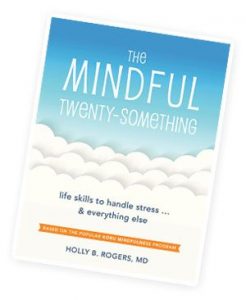
It was the morning meditation on the second day of my retreat, and honestly, I was feeling restless and frustrated. My mind wouldn’t settle and my body was itching to move. To make things worse, I was becoming self-critical, scolding myself for struggling.
Our teacher, Joseph Goldstein (one of my personal heroes), was leading the meditation. At one point Joseph advised, “When you notice you have become distracted, simply begin again.”
When you notice you have become distracted, simply begin again.
“Oh right, this is simple,” I remembered. So I let go of the criticisms, and relaxed into beginning anew, bringing my attention back to the feel of my breath. It was helpful to be reminded that meditation doesn’t have to be hard. It doesn’t have to be a struggle.
Slipping into the present moment is as easy as noticing the feel of your breath.
In the midst of your meditation session, your mind will inevitably strike out on its own. Something compelling will hook it, and it will be off and running. But here’s the thing: No matter how deep you are into organizing your day, or writing that explanatory email, or finally winning that argument with your partner, at some point you will recognize that you have become lost in your thoughts.
That moment of recognition, is perfect mindfulness. You are seeing exactly what your mind is doing. And in that moment, without drama or recriminations, you can simply begin again.
Feel your body sitting. Feel your body breathing. Begin to gently count the slow in and out of your breath. When you get to ten, begin counting backwards back down to one. Don’t try to force concentration. Rather, cultivate interest in the ever-changing nature of your breathing. If you cultivate curiosity, concentration will follow in time.

You will likely end up in another mental argument or vast planning session before you get back to one. And when you notice that, simply begin again.
Do you have a great simple strategy for getting back on track when you get derailed during meditation? If so, please share it in the comments below .
Photo credit: Sarah Bürvenich on Unsplash
Get our latest articles in your inbox.

I have found that learning about the “stages of meditation” has been one of the most helpful guides to understanding how distractions happen – and how to move past them.
The stages have been written about in many ways, but I found that the images used by Tibetan teacher Orgyen Chowang especially helpful.
He speaks of the “calm mind highway” – a metaphor for calmly, non reactively observing/feeling the flow of breath.
Stage 1: You’re driving along the calm mind highway (observing the breath) and you take the first exit off (follow the distracting thought into blah blah blah). Perhaps once or twice you realize you’ve driven off the highway and take the ramp to get back on (come back to your breath). Congratulations – if you’re a beginner, you now realize, perhaps for the first time in your life, just how wild your mind is.
Stage 2 You drive along, take an exit, and now, instead of staying off the highway for most or all of the session, you get back on, and maybe you’re able pass two or three exits (let two or three trains of thought go by before getting back onto the calm mind highway).
Stage 3: Now, you stay on the calm mind highway for several minutes or more at a time, and you only get sidetracked (take the off ramp) a few times a session.
Stage 4: Now, no matter how many times you’re tempted to take the exit, you never do. You keep driving along the calm mind highway the whole session (you stay with the breath). you’re aware of the thoughts beckoning you to take the exit, but you let them go.
This is considered the first major milestone in meditation practice. This model is nearly 1500 years old, and tens of thousands of meditators have used it to guide them throughout their lives. I find it immensely helpful as a way of knowing where I am in practice.
For what it’s worth, there are 8 stages altogether, and stage 7 is where it begins to become effortless. John Yates (aka Culadasa) presents a neuroscience-informed view of the stages in his book, “The Mind Illuminated.” And he goes into tremendous detail how to transition from the stage of effort (which you’re still at as of stage 4) to the stage of effortlessness (in stage 7).
Alan Wallace, in “The Attention REovlution,” has a much simpler version. Stages 5-6 simply involve letting go of the breath, and being present, noticing thoughts but letting them go. At stage 7, you can simply rest in the experience of being aware, ignoring thoughts and breath.
Once you have a sense of this trajectory, at any moment, you can know where you’re at. If you have been practicing at stage 4 for awhile, and you find yourself slipping back into earlier more easily distracted stages, you know you need to apply more diligence, more energy, perhaps a more concrete, step by step technique. If you’re sailing along in stage 4 or 5, you know that by relaxing more and letting go of conscious effort, your practice will spontaneously move on to more advanced stages.
it’s almost a precise way of knowing, at any moment, whether in formal practice or throughout the day, exactly what to do to deepen your practice. As the sense of what the stages are deepens further, it’s almost like having a personal teacher with you at every moment, even as you shift into dreaming and sleep, and I imagine, even in the dying process.
Don, thanks so much for this lovely teaching. The metaphor of a highway with many exits is an apt one for meditation. I find, and I notice my students find, that on different days and at different times I might be at stage 3, and then the next day back to stage 1, and then experience a bit of stage 4.
I think new meditators have the hope, maybe even expectation, that it is a linear process, and thus get frustrated if they feel they are “backsliding” to an earlier stage. I find it is pretty normal to cycle through the different stages, maybe even during the same meditation period. I’m curious about your thoughts on this.